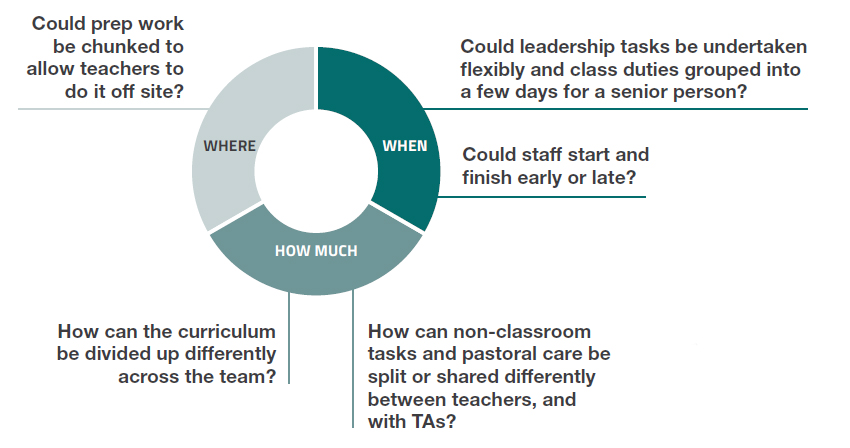Current practice around flexible working in
secondary schools
Around 17%
of secondary school teachers work part-time1,
well below the 27% national rate for all workers. And, in a
female-dominated profession, significantly behind the 42% national rate for
women working part-time. Part-time work at a senior level in schools is even rarer:
only 3% of heads do so, compared with 13% of directors and managers across the
whole workforce2.
The
prevalence of other types of flexible working is harder to quantify.
Anecdotally, many schools have a number of informal arrangements, such as late
starts or working partly from home.
But overall it seems that flexibility of any type is granted on an
ad-hoc basis, in response to requests from valued employees. It’s rare to find
a school which is proactive about offering part-time and flexible roles.
The case for change
Retention:
The
lack of part-time and flexible roles has been identified as a key reason for
the teaching brain drain. When they leave the profession for a different one, many
secondary teachers reduce their
hours3.
Attracting
new and returning teachers: Recruitment data from the TES suggests that
only 6.6% of secondary teaching jobs are advertised as part-time. Meanwhile, 46% of teachers who have
taken a career break report that a lack of flexible or part-time opportunities
was a barrier to returning to the
profession4.
Progression: The low
proportion of SLT members working flexibly or part-time means that there isn’t
a visible career pathway for ambitious teachers who want or need to work in
this way. Data around the sector’s gender pay gap suggests that it is
particularly difficult for women to progress. Almost three-quarters of teachers
are women, but only a third of secondary heads and two-thirds of primary heads
are.
What are the barriers to making teaching
flexible?
Structural
barriers: The logistics of timetabling are often cited as the biggest
obstacle to flexible working. Staff:student ratios and providing cover for
absences also pose challenges.
Budget: There is a
belief that flexible working involves extra costs. (However there is no
evidence from other sectors that flexible working is more expensive in the long
run – especially when balanced against the costs of recruiting and training
replacement staff.)
Workload
and the intensity of the school day: Teachers worry that moving to
part-time will mean a full-time workload for part-time pay, and that they will
have to sacrifice their non-teaching time. And management fear that part-timers
won’t be prepared to work extra hours.
Cultural
and attitudinal barriers: There are many widely held beliefs about the
infeasibility of flexible working within secondary schools. These include: a
fear of ‘opening the floodgates’; concerns around fairness and the validity of
reasons to work flexibly; potential negative impact on students; management
capacity to manage a flexible workforce.
Timewise recommendations for schools
To help overcome barriers, challenge outdated perceptions, and
create opportunities for flexible working, Timewise has developed a six-step
framework for schools to use. Details of this can be found in the full report.
In particular, Timewise identifies a need for training support in how to design flexible jobs. This will require management teams to consider when, where and in how much time the various aspects of teaching work are done, and consider whether they can be done differently.
Flexible job design options for teachers and schools
Areas for further exploration
The report identifies some of the key areas for focus within
individual schools, but there is a great deal of work to be done at a sector
level by the DfE and other stakeholders. Timewise recommends, and is actively exploring,
further research and analysis into the following areas:
- The impact on students whose teachers work
flexibly
- The extent to which flexible jobs could impact
retention and recruitment
- The extent to which timetabling is an obstacle,
or whether current processes and software are adaptable to more flexibility
- The financial implications of flexible
working.
Please get in touch if you are interested in investigating any or all of these areas further.
Published July 2019
Download full research report
Sources
1
Teacher Retention and Turnover Research, Interim Report, NFER, 2017
2 ONS
3
Teacher Retention and Turnover Research – Is the Grass Greener Beyond
Teaching?, NFER, 2017
4 Exploring Flexible Working Practice in
Schools, Literature review, DfE, 2019
6 Flexible Working in Schools, Guidance for
local authorities, maintained schools, academies and free schools, DfE, 2017



